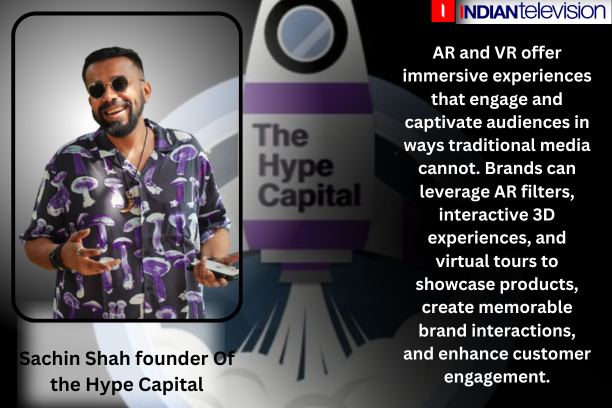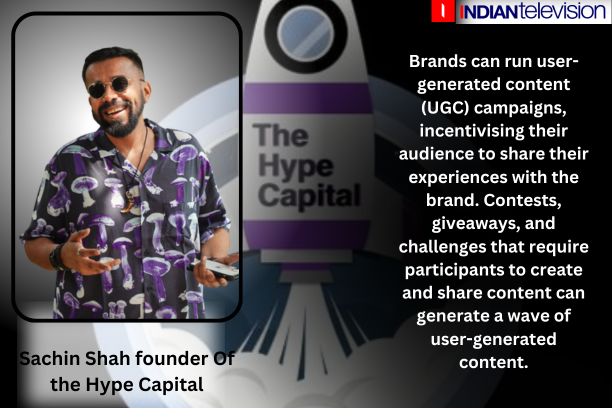Mumbai: With its vision to be the HYPE Capital of the world and work with brands, content creators, and celebrities across the globe, The Hype Capital envisions a connected world where people and brands can effortlessly share ideas, build relationships, and collaborate on a global scale. The company believes that technology should enhance human connections, break down barriers, and promote inclusivity.
The company has a wealth of experience working with some of the most renowned companies and individuals in this field and has a comprehensive understanding of sports, F&B, nightlife & entertainment industries. Anil Kumble, Harbhajan Singh, Cheteshwar Pujara, and Robin Uthappa are a few of the reputed cricketers The Hype Capital is working with. The company has also collaborated with companies including Crickstore, sLick Entertainment, Nustart Sports, Tenvic Sports, Spektacom Technologies, St. Anthony's Goa, O'Aido Goa, Bobby's Fat Fish Goa, HappyGrub, Redroom, and others.
Indiantelevision.com in an email interaction spoke to Sachin Shah founder Of the Hype Capital to connect people and brands globally through technology for inclusive collaboration.
On the role of the user, segmentation helps in creating targeted social media campaigns
By dividing the target audience into distinct groups based on demographics, interests, behaviours, and preferences, businesses can tailor their content and messaging to resonate with each segment. This approach ensures that the right message reaches the right audience, increasing engagement and conversions. Segmentation allows for personalised communication, allowing brands to address specific pain points and provide relevant solutions. It also enables marketers to optimise their ad spend by focusing resources on the segments that are most likely to convert, resulting in higher ROI and campaign effectiveness.

On the key advantages of using social media for business marketing compared to traditional methods
In today's ever-evolving digital landscape, social media has emerged as an indispensable component of marketing strategies. With an overwhelming number of active users on popular platforms like Facebook, Instagram, and Twitter, the race to captivate audiences and foster meaningful engagement has reached new heights.
Social media allows real-time, two-way communication between businesses and their audience, fostering engagement, and building relationships. It provides a platform for immediate feedback, enabling brands to adapt their strategies and offerings based on customer insights. Besides that, social media offers a higher level of targeting and segmentation options, ensuring that businesses can reach their ideal audience with precision. Also, social media is cost-effective, allowing businesses to reach a wide audience at a fraction of the cost of traditional advertising. Lastly, social media provides extensive data analytics and reporting, allowing businesses to measure their performance, track conversions, and optimise their marketing strategies in real-time.

On the role, storytelling plays in building a strong social media presence
Storytelling allows brands to connect with their audience on an emotional level and create a narrative that resonates with their values and aspirations. Storytelling humanises the brand, making it relatable and engaging. By sharing compelling stories, brands can capture attention, evoke emotions, and build a community of loyal followers. Storytelling can be leveraged through various content formats such as videos, blog posts, and social media posts. It is essential to craft narratives that align with the brand's identity and values, keeping the audience at the centre. Authenticity, creativity, and consistency are key to successfully leveraging storytelling for a strong social media presence.

On disruptive technologies, such as augmented reality or virtual reality, changing the landscape of social media marketing
In the fast-paced world of social media marketing, disruptive technologies have revolutionised how brands and marketers engage with their target audience. And, the emergence of disruptive technologies has brought about significant transformations in various industries, including social media marketing. Modern technologies have fundamentally altered how businesses interact with their target audiences, opening up new marketing and advertising options. Virtual reality, artificial intelligence, and augmented reality are just a few examples of disruptive technologies that have substantially changed how social media marketing is done.
AR and VR offer immersive experiences that engage and captivate audiences in ways traditional media cannot. Brands can leverage AR filters, interactive 3D experiences, and virtual tours to showcase products, create memorable brand interactions, and enhance customer engagement. These technologies provide opportunities for virtual product try-ons, experiential marketing campaigns, and virtual events, bringing brands closer to their audience and driving deeper connections. AR and VR also facilitate social sharing, as users are more likely to share unique and immersive experiences, amplifying brand reach and virality.
Additionally, social media marketers can benefit greatly from the data-driven insights provided by AI-powered analytics. AI algorithms are excellent at seeing patterns, trends, and correlations in vast amounts of data processed in real time, providing marketers with in-depth audience insights. These insights are essential for streamlining targeting tactics, improving content strategy, and identifying untapped growth potential. Brands and marketers may make well-informed decisions and succeed in the changing world of social media marketing by utilising data-driven insights.

On businesses encouraging their audience to generate and share content related to their brand
Brands can run user-generated content (UGC) campaigns, incentivising their audience to share their experiences with the brand. Contests, giveaways, and challenges that require participants to create and share content can generate a wave of user-generated content. Secondly, businesses can actively engage with their audience by responding to their comments, acknowledging their contributions, and featuring their content on official brand channels. This recognition motivates the audience to continue generating and sharing content. Lastly, businesses can collaborate with influencers or brand ambassadors who can inspire and encourage their followers to create and share content related to the brand. By fostering a sense of community and appreciation, businesses can effectively stimulate audience-generated content. It is a tough nut to crack, and requires a lot of patience, but when has phenomenal results in the long run.
On best practices for maximising return on investment (ROI) through social media advertising
Defining clear objectives and key performance indicators (KPIs) is essential to measure the effectiveness of campaigns accurately. Businesses should align their advertising goals with their overall marketing objectives. Secondly, thorough audience research and segmentation enable businesses to target the right audience with tailored messaging, optimising conversion rates. Thirdly, continuous monitoring and optimisation of campaigns based on real-time data are critical to maximise ROI. Regularly analysing campaign performance, testing different ad formats, and refining targeting parameters contribute to ongoing improvement. Lastly, leveraging remarketing techniques to re-engage with interested audiences and utilizing A/B testing to optimise ad creative and copy can significantly improve ROI in social media advertising. The key takeaway is that brands should have well-defined goals, experiment a lot, analyse the data of the experiments and improvise.
On the ways of brands currently utilising Artificial Intelligence (AI) in their social media advertising and marketing strategies
AI-powered algorithms analyse vast amounts of data to generate actionable insights, enabling brands to optimise targeting, content creation, and ad placements. AI-powered chatbots provide personalised customer interactions, handle inquiries, and offer recommendations. AI also plays a role in content curation, analysing trends, and user preferences to suggest relevant content. Additionally, AI assists in sentiment analysis, monitoring brand mentions, and social listening, allowing brands to proactively respond to customer feedback and manage their online reputation effectively. As AI continues to advance, brands are exploring new possibilities such as predictive analytics, dynamic ad optimisation, and voice recognition technologies to further enhance their social media advertising and marketing strategies.
On AI assisting social media marketers in generating and delivering more impactful content for brands and marketers
By analysing vast amounts of data, AI algorithms can identify patterns, trends, and user preferences, allowing marketers to create highly relevant and personalised content. AI-powered tools provide insights into optimal posting times, and content formats, and even suggest content ideas based on audience interests. AI also aids in automating repetitive tasks, freeing up marketers' time to focus on strategy and creative aspects of content creation. Additionally, AI-driven image recognition and natural language processing enable brands to create visually appealing content and craft compelling messaging that resonates with their audience. Overall, AI empowers social media marketers to deliver more relevant, engaging, and impactful content that drives audience engagement and achieves desired marketing outcomes.
On the key steps which businesses need to be taken when faced with a social media crisis
When faced with a social media crisis, businesses should act swiftly and strategically to mitigate potential damage. The following key steps can help navigate through a crisis effectively:
a. Monitor and Assess: Actively monitor social media platforms to identify the issue and gauge its severity. Understand the sentiment, reach, and impact of the crisis on the brand's reputation.
b. Respond with Transparency: Respond promptly and transparently, addressing concerns and providing accurate information. Acknowledge any mistakes or issues and offer a genuine apology if necessary.
c. Centralise Communication: Designate a central spokesperson to handle communication and ensure a consistent message across all channels. Avoid conflicting statements and provide regular updates to keep stakeholders informed.
d. Engage with the Audience: Engage with affected individuals directly, offering support and assistance. Show empathy, address concerns, and provide reassurance where appropriate.
e. Monitor and Manage Sentiment: Continuously monitor social media platforms, addressing negative sentiment and responding to queries or comments promptly. Engage in constructive conversations and actively participate in the resolution process.
f. Learn and Improve: Once the crisis is resolved, conduct a thorough review to identify lessons learned. Update crisis management protocols, refine social media strategies, and implement measures to prevent similar situations in the future.






